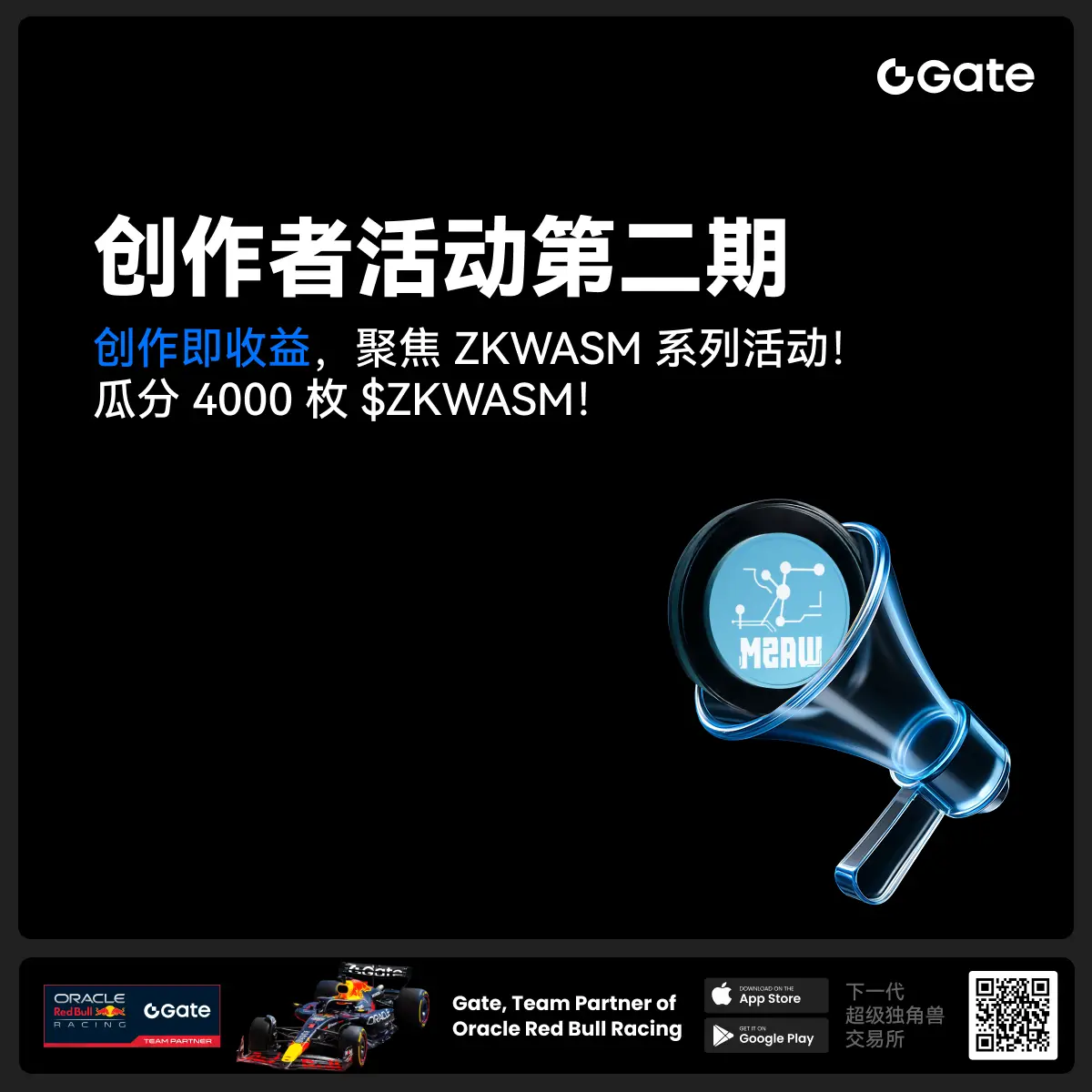- 话题1/3
36378 热度
41392 热度
37276 热度
54588 热度
21596 热度
- 置顶
- 📢 Gate广场 #创作者活动第二期# 正式开启!
聚焦 ZKWASM 系列活动,分享你的观点,瓜分 4,000 枚 $ZKWASM!
ZKWASM 作为 zk 公链先锋,正在 Gate 平台重磅推广!
三大活动联动上线:Launchpool 认购、CandyDrop 空投、Alpha 专属交易——不要错过!
🎨 活动一:发布广场贴文,赢内容奖励
📅 时间:7月25日 22:00 - 7月29日 22:00(UTC+8)
📌 参与方式:
- 在 Gate 广场发布与 ZKWASM 或其三大活动相关的原创内容(不少于 100 字)
- 添加标签: #创作者活动第二期# #ZKWASM#
- 附本人参与 Launchpool/CandyDrop/Alpha 的截图(如认购、空投或交易)
🏆 奖励设置:
- 一等奖(1名):1000 枚 $ZKWASM
- 二等奖(2名):500 枚 $ZKWASM
- 三等奖(10名):100 枚 $ZKWASM
📋 评选标准:内容质量、互动量、项目相关性,附活动参与截图者优先。
📢 活动二:发推赢传播力奖励
📌 参与方式:
- 在 X(推特)发布与 ZKWASM 或三大活动相关的原创内容(不少于 100 字)
- 添加标签: #ZKWASM # GateSquare
- 填写登记表 👉 https://www.gate.com/quest
- 📢 Gate广场 #MBG任务挑战# 发帖赢大奖活动火热开启!
想要瓜分1,000枚MBG?现在就来参与,展示你的洞察与实操,成为MBG推广达人!
💰️ 本期将评选出20位优质发帖用户,每人可轻松获得50枚MBG!
如何参与:
1️⃣ 调研MBG项目
对MBG的基本面、社区治理、发展目标、代币经济模型等方面进行研究,分享你对项目的深度研究。
2️⃣ 参与并分享真实体验
参与MBG相关活动(包括CandyDrop、Launchpool或现货交易),并晒出你的参与截图、收益图或实用教程。可以是收益展示、简明易懂的新手攻略、小窍门,也可以是现货行情点位分析,内容详实优先。
3️⃣ 鼓励带新互动
如果你的帖子吸引到他人参与活动,或者有好友评论“已参与/已交易”,将大幅提升你的获奖概率!
MBG热门活动(帖文需附下列活动链接):
Gate第287期Launchpool:MBG — 质押ETH、MBG即可免费瓜分112,500 MBG,每小时领取奖励!参与攻略见公告:https://www.gate.com/announcements/article/46230
Gate CandyDrop第55期:CandyDrop x MBG — 通过首次交易、交易MBG、邀请好友注册交易即可分187,500 MBG!参与攻略见公告:https://www.gate.com/announcements
- 📢 #Gate广场征文活动第三期# 正式启动!
🎮 本期聚焦:Yooldo Games (ESPORTS)
✍️ 分享独特见解 + 参与互动推广,若同步参与 Gate 第 286 期 Launchpool、CandyDrop 或 Alpha 活动,即可获得任意奖励资格!
💡 内容创作 + 空投参与 = 双重加分,大奖候选人就是你!
💰总奖池:4,464 枚 $ESPORTS
🏆 一等奖(1名):964 枚
🥈 二等奖(5名):每人 400 枚
🥉 三等奖(10名):每人 150 枚
🚀 参与方式:
在 Gate广场发布不少于 300 字的原创文章
添加标签: #Gate广场征文活动第三期#
每篇文章需 ≥3 个互动(点赞 / 评论 / 转发)
发布参与 Launchpool / CandyDrop / Alpha 任一活动的截图,作为获奖资格凭证
同步转发至 X(推特)可增加获奖概率,标签:#GateSquare 👉 https://www.gate.com/questionnaire/6907
🎯 双倍奖励机会:参与第 286 期 Launchpool!
质押 BTC 或 ESPORTS,瓜分 803,571 枚 $ESPORTS,每小时发放
时间:7 月 21 日 20:00 – 7 月 25 日 20:00(UTC+8)
🧠 写作方向建议:
Yooldo
- 🎉Gate 2025 上半年社区盛典:内容达人评选投票火热进行中 🎉
🏆 谁将成为前十位 #Gate广场# 内容达人?
投票现已开启,选出你的心头好
🎁赢取 iPhone 16 Pro Max、限量周边等好礼!
📅投票截止:8 月 15 日 10:00(UTC+8)
立即投票: https://www.gate.com/activities/community-vote
活动详情: https://www.gate.com/announcements/article/45974
- 📢 #Gate广场征文活动第二期# 正式启动!
分享你对 $ERA 项目的独特观点,推广ERA上线活动, 700 $ERA 等你来赢!
💰 奖励:
一等奖(1名): 100枚 $ERA
二等奖(5名): 每人 60 枚 $ERA
三等奖(10名): 每人 30 枚 $ERA
👉 参与方式:
1.在 Gate广场发布你对 ERA 项目的独到见解贴文
2.在贴文中添加标签: #Gate广场征文活动第二期# ,贴文字数不低于300字
3.将你的文章或观点同步到X,加上标签:Gate Square 和 ERA
4.征文内容涵盖但不限于以下创作方向:
ERA 项目亮点:作为区块链基础设施公司,ERA 拥有哪些核心优势?
ERA 代币经济模型:如何保障代币的长期价值及生态可持续发展?
参与并推广 Gate x Caldera (ERA) 生态周活动。点击查看活动详情:https://www.gate.com/announcements/article/46169。
欢迎围绕上述主题,或从其他独特视角提出您的见解与建议。
⚠️ 活动要求:
原创内容,至少 300 字, 重复或抄袭内容将被淘汰。
不得使用 #Gate广场征文活动第二期# 和 #ERA# 以外的任何标签。
每篇文章必须获得 至少3个互动,否则无法获得奖励
鼓励图文并茂、深度分析,观点独到。
⏰ 活动时间:2025年7月20日 17
PayFi:Web3支付新蓝海 合规先行 前景广阔
PayFi:Web3支付的新篇章
近日,一场备受瞩目的行业大会在香港召开,某集团董事长将发表关于合规稳定币的全球支付新网络的主题演讲。作为Web3领域的重要人物对支付的关注,无疑令人振奋。这不仅意味着Web3支付行业的广阔空间,或许也暗示着Web3支付爆发在即。
前景广阔,挑战重重,这是PayFi当下的真实写照。
合规和高难度的风险管理是必要条件,这决定项目是否能走得长远。从长远角度看,我们需要关注当前监管合规的良性发展,合规之路正在逐步提速。对于一个PayFi项目而言,除了创新玩法和强化风险管理,挑选具有合规牌照的合作伙伴就是重中之重。无论是稳定币还是交易所,一旦形成合力,则无疑是广阔天地,大有可为。
PayFi是新概念,但解决的是旧问题
资金的周转效率是货币时间价值的核心
PayFi(Payment Finance),也就是支付金融,是Web3领域独有的概念,最早由某基金会主席提出,定义为围绕货币时间价值构建的新型金融市场。
货币时间价值意味着货币在不同的时间段具有不同的价值。用经济学的方式理解,就是在不考虑通胀因素下,货币价值的上升来自于货币/资金让渡使用权所带来的价值增值。通俗地说,就是用今天的1美元来进行投资、理财、借贷等行为,在未来的某个时刻,你赚到了更多的钱,而你赚的钱则直接决定于这1美元的周转效率、成本以及每次周转的收益。
那么为什么需要Web3来进行支付改造?结论是Web2中的货币时间价值被大大削弱了,这里面既有成本的增长、也有收益的降低,更有便捷获取服务的程度不高。
PayFi是通过区块链技术,基于支付结算场景,围绕资本周转效率、成本及收益为目的的创新金融市场。值得注意的是,能够提高货币时间价值的场景有很多,但PayFi更多的是聚焦支付及结算,而非金融交易,其对时间价值的主要提升在于,更短的资金结算时间以及更快的周转效率。
RWA需求未必刚性,但PayFi则更为紧迫
Web3行业有一个公认且经久不衰的主流叙事,即大规模采用(Mass Adoption)这一关键命题。RWA赛道正是诞生在这一叙事之下的重点方向,而PayFi从更广义的角度则隶属于RWA赛道,因为从最核心的基础而言,都是区块链世界与真实物理世界的交互,只不过是交互的方式有所不同。
RWA最核心的定义是真实世界的资产上链,将有形的现实直接资产进行代币化/NFT,使之能够在链上进行交易,聚焦的是现实资产在链上的交易,为现实资产提供更高的流动性;PayFi则聚焦的是现实资产之间交易的快捷以及未被满足的金融需求通过区块链得以实现。
RWA的需求未必是刚性,它某种程度是给区块链世界提供了更多的收益/资金来源;PayFi的需求是完全刚性需求,它在某种程度上,更多是给现实世界提供了更多的收益/资金来源。
区块链的发展瓶颈呼唤具有真实场景的新叙事,PayFi上限极高
从区块链世界看,叙事枯竭是当前区块链世界不争的事实,流动性分割的现象几乎是越演越烈,伴随的则是项目数据的虚假繁荣,在项目TGE以后,多数项目的用户数据几近直线下跌,同时也伴随着币价的大幅走低。这种现象从好的方面呈现出区块链世界在资本加持以及逐步合规化加持下的高速发展,从不好的方面则反映出当前的诸多项目背后并没有真实的需求场景,多数为套娃项目,自身造血能力极弱,如果没有资本加持,几乎是"见光死"。
从真实世界看,在日益复杂的地缘政治环境中,日渐庞杂臃肿的国际支付结算体系不仅面临效率低下的积重难返,更饱受中立、平等立场的质疑,某国被剔除某支付系统无疑是先例,但绝不是最后一例。此外,金融的寡头化与不平等现象比比皆是,更为糟糕的是,这种现象仍在加剧。
很难说区块链能够完美地解决现实世界的问题,况且区块链本身也正面临发展瓶颈,但它至少是目前最有可能的路径之一。无论是Web2的巨头还是Web3的顶流,无疑都不愿意错过对这个赛道的押注,比如某些知名投资机构等。更重要的是,对巨头的天量级资本而言,他们更多的不会被短期有限的财富效应吸引,而更加注重长远的增量空间,无论RWA还是PayFi能吸引到大资金的核心原因也正是如此。
PayFi生态初具雏形,从稳定币到交易所,合规是合作基础
更广泛的生态依赖于具有合规资质的合作方
PayFi赛道是区块链世界去撬动天量的真实世界资产,在这个赛道图景上,如果单纯去分析PayFi的个别项目本身,无疑是一叶障目,更需要看到的是,在这样一个区块链生态中,如何形成更广泛的合力去创造新的金融范式。
PayFi链接的是区块链世界的资金池和链下世界的金融需求,这种链接关系需要整合多重力量。
首要因素是必须要在一个相对宽松的监管环境和加密友好的城市进行运营。比如某些城市就是较为适合的选择。
其次,目前的主要合作方仍然聚焦在需要能够提供全套出入金、流动性提供、去中心化基础设施合规服务方案的大型持牌机构,事实上,从这点上来说,这也是目前PayFi的高门槛及规模增长的阻碍之一。
以某地区为例,具有一定资金实力、从基础设施、出入金、流动性包括KYC等均能提供合规监管框架的实体公司并不多,只有少数的监管持牌机构。与这类合规机构合作的好处在于,其合作的广度和深度以及对协同难度下了一个等级,更有利于项目快速搭建以及扩大知名度,否则需要在不同的环节寻找不同的合作伙伴,这某种意义上加大了项目的运营成本。
赛道雏形已现,未来值得期待
RWA是本轮周期的一大热点,但是PayFi概念也仅仅是今年7月份提出,在某龙头项目9月份融资3800万美元的热度之下,才陆续广泛传播,不到三个月的时间,已经成为行业内炙手可热且备受关注的新概念和新叙事,其背后集结了业内顶级风投、合规交易所以及公链基金等。
在今年的某地区Token2049中,PayFi Summit活动也集中展示了12个PayFi赛道的项目以及相应的底层模块化Stack技术堆栈,意图进一步降低项目开发的门槛。
从合规角度,目前支付业务在不同地区有不同的监管框架,如某些地区的特定牌照等都是项目进入支付赛道必须要考量的监管框架。
总的来看,赛道当前的规模、热度尚称不上主流;但在行业新叙事乏力的背景下,行业给予的高度关注也间接证明对这一方向的认可,至少在当前的影响力下,赛道雏形已然成形,未来仍然值得期待。
PayFi的三大挑战:合规是发展基础、风控是发展保障,降低门槛是发展杠杆
展望未来,对于PayFi发展而言,最需要克服的是监管合规,其次是在于如何通过流程管理,贯通从链上到链下的全场景,涉及到主要挑战如下。
**挑战1: 整个链条的合规化管理。**从风险视角,链上合规风险如果蔓延至链下,则对项目会形成致命打击,因此采用合规稳定币只是第一步;更长远的看,当前的稳定币均挂钩美元,在大规模推广的过程中,可能会面临跨国之间的外汇管制风险,比如近期某国亦打算出台相关规定。此外,在出入金环节、流动性提供环节的合规都对项目成败起到了决定性的作用。
**挑战2: 技术和安全风险以及信用风险的管理难度增大。**如果业务形态纯粹发生在链上,技术风险相对比较集中,PayFi的业务形态决定了,其技术风险不仅存在于链上的黑客攻击,更存在于线下的履约见证等风险,此外无论是基于应收帐款或者是贸易,需要大量线上线下的数据交叉验证,而且没有实地的线下调研,这其实也对其信用风险管理能力提出了更高的要求。
**挑战3: 用户的进入门槛仍然较高。**从目前的PayFi项目来看,由于考虑到监管合规的因素,用户的KYC以及投资门槛目前都不太适合广大散户参与,比较合适机构/高净值人群参与,但从业务逻辑上来说,机构业务更容易开展,模式相对简单,但是假设后续要大规模推广,则用户门槛仍然是壁垒之一。
建议与前景:立足合规,多方合作,创新玩法,大有可为
从PayFi的发展来看,当前还处在单向的融资方案的解决,也就是为真实物理场景寻找区块链世界的融资,如果更进一步则可以发展成为支付融资一体化的业务,或者可以说是PayFi+Defi+RWA的综合形态,一方面扩大资金来源,同时提高链上DeFi或交易所理财产品的收益来源;另一方面也为线下资产庞大的金融周转需求寻找突破方案。
当前的PayFi资金池并不直接自于DeFi和交易所,更多来自项目本身自建的资金池。然而对于底层资产而言,在合规资金下,其无所谓资金来源,尤其是考虑当前市场的流动性分割的现状,可以考虑于Defi协议、合规交易所进行合作,充分整合区块链世界的流动性,一方面可以设计更多的资金风险属性、期限的产品,同时还可以实现支付融资一体,或者说利用区块链支付结算的高时效,结合链上收益,无缝实现支付融资一体。相当于,用户通过LP获取的收益作为抵押,可以即时获得PayFi平台的信用垫款,直接用于支付线下消费。
此外,对于中心化合规交易所和Defi协议而言,更是多了用户资金留存的有效抓手,一个可能的场景是:比如用户A通过某交易所出入金,在投资BTC收益后,可以用BTC或者USDC等合规稳定币投入交易所的理财产品,该理财产品的底层资产为PayFi的融资项目,以赚取稳定的收益,该收益也可以直接通过PayFi进行线下支付。
总而言之,从PayFi自身发展来看,结合区块链世界的玩法众多,货币的时间价值可以充分利用区块链的高效进行革新,而缩短的时间不仅可以提高周转效率,也可以更为方便的形成支付、融资、结算一体的产品形态。
据不完全统计,整个支付领域,仅信用卡、贸易融资、跨境支付等加总就有超过40万亿美元的市场,而当前PayFi仅仅是在传统金融被忽视的长尾市场进行了拓展。
结合日益合规化的区块链世界,仅以PayFi而论,这个规模粗略估计也超过万亿规模。在可预见的未来,如果在打通出入金障碍、线上线下融合加深、合规提速的背景下